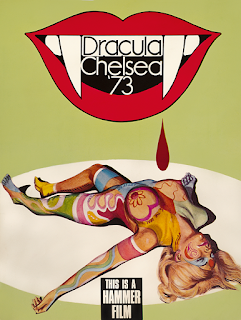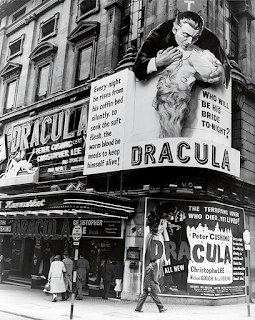 Last week, Reel Art Press kindly allowed me to share a selection of images from their 272-page hardcover book that explores the evolution of the cinematic vampire, aptly titled, 'Vampire Cinema: The First One Hundred Years'. But if you missed it, don't worry, because you can check it out by clicking here. Otherwise, you can just go with the flow and dive into the following Q and A with the author of this book, Christopher Frayling. Please enjoy.
Last week, Reel Art Press kindly allowed me to share a selection of images from their 272-page hardcover book that explores the evolution of the cinematic vampire, aptly titled, 'Vampire Cinema: The First One Hundred Years'. But if you missed it, don't worry, because you can check it out by clicking here. Otherwise, you can just go with the flow and dive into the following Q and A with the author of this book, Christopher Frayling. Please enjoy.1) Name three words that best describe who you are. I'm a cultural historian and broadcaster, but I've also been called, "the Van Helsing de nos jours", and by the people working at 'The Guardian' newspaper, "a teddy bear on speed".
2) How would you describe your book, 'Vampire Cinema'? 'Vampire Cinema' is a celebration (and an exploration) of the first hundred years of this deathless form of entertainment, ranging from the 1922 silent classic, 'Nosferatu', all the way to the 2022 Marvel movie, 'Morbius'. It's designed and presented to the highest visual standards, because too often, books about horror cinema don't always look very good. This one certainly does, though, and it includes a lot of new research as well as rare stills, posters, and pressbooks.
3) What was the first vampire film you saw and what were your initial impressions of it? The first vampire film I saw was Hammer's 1958 version of 'Dracula'. It had an 'X' certificate and I was underage at the time. But despite this, I decided to cycle from boarding school to my local cinema, the Majestic, located in Swadlincote, South Derbyshire, and because I stayed on for the disintegration scene (of course), I was late back at school and punished for it by being beaten with a gym shoe (as we used to call them).
I thought then and I still think that it was well worth it, as the images from that film are still with me today, like scary illustrations from a children's book. I'm particularly fond of the scene where the Count (Christopher Lee) crumbles into dust as the sun beams through the castle's curtains, while Van Helsing (Peter Cushing) improvises a crucifix with two metal candlesticks. Indelible.
4) What song would you say best represents your book and why? To answer this question, I'd like to select the song, 'Bela Lugosi's Dead', by the goth rock band, Bauhaus, because, thanks to cinema, I know that Lugosi is immortal, and the song coincided with the opening up of vampire films (beyond their Victorian origins in Bram Stoker and Sheridan Le Fanu). A goth anthem.
5) 'Vampire Cinema' looks like a great book full of fun and filmic facts. But what would you say is the most surprising fact featured in it? For me, the most surprising fact I discovered for this book, originates in a village on the edge of the Amazonian rainforest. While there, I saw a vampire bat and noticed that it's tiny (about the size of a human thumb), rather attractive (relatively), and doesn't suck blood at all (instead, it laps or licks it as the blood flows). In films and literature, vampires tend to be huge, plug-ugly, creatures that suck blood from human veins. Whereas in, 'Vampire Cinema', I explain how this transformation occurred (it's unfair to bats).
And on that note, I'd like to thank Christopher Frayling for telling us about his book, 'Vampire Cinema: The First One Hundred Years', before encouraging you to check out the official Reel Art Press website for further information. Or better yet, why not pick up a copy via Amazon!
*** Please Note: Images credited to mptvimages
VAMPIRE CINEMA - MY INTERVIEW WITH CHRISTOPHER FRAYLING
 Reviewed by David Andrews
on
October 24, 2022
Rating:
Reviewed by David Andrews
on
October 24, 2022
Rating:
 Reviewed by David Andrews
on
October 24, 2022
Rating:
Reviewed by David Andrews
on
October 24, 2022
Rating:





No comments:
Post a Comment